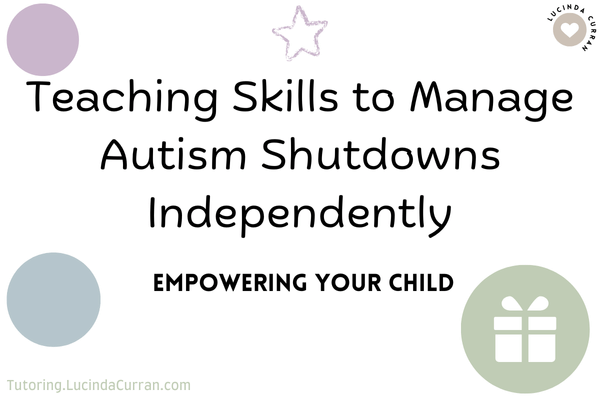Teaching Skills to Manage Autism Shutdowns Independently: Empowering Your Child
While it’s crucial to provide support and comfort during an autism shutdown, an equally important goal is to equip your child with the skills to manage these moments on their own when you’re not around.
Empowering your child to recognise their own triggers and cope with sensory or emotional overload can help them feel more confident and capable of managing shutdowns independently.
In this section, we’ll explore practical strategies and skills you can teach your child to help them handle autism shutdowns when they aren’t with you.
1. Teaching Self-Awareness and Recognising Triggers
The first step in helping your child manage their emotions and sensory overload is teaching them to recognise when they’re about to experience a shutdown.
Self-awareness is a powerful tool that allows your child to identify the early signs of overwhelm before it leads to a shutdown.
- Create a “Feelings Chart”: Develop a visual chart or list with your child that helps them identify different emotions or sensory feelings they may experience. Use colours, pictures, or simple words to label feelings like “anxiety,” “anger,” or “overwhelmed.” As your child becomes more familiar with the chart, encourage them to refer to it when they start feeling uncomfortable.
- Body Cues: Help your child learn to recognise physical cues that signal they are getting overwhelmed. These might include clenched fists, shallow breathing, or a tense body. Discuss these physical responses and practise calming strategies, like deep breathing, when these signs appear.
- Empower with Words: If your child struggles with verbal communication, work on building a set of words or phrases they can use to express when they’re feeling overwhelmed. Phrases like “I need a break” or “I’m feeling too much” can help them advocate for themselves.
2. Teaching Coping Strategies for Independence
Once your child is able to recognise when they are beginning to feel overwhelmed, the next step is teaching them coping strategies to manage their feelings. These techniques can help them regulate their emotions or sensory responses and reduce the likelihood of a shutdown.
- Deep Breathing: One of the most effective self-regulation tools is teaching your child how to breathe deeply when they start to feel overwhelmed. Practice “belly breathing” by encouraging them to inhale slowly through the nose, hold for a few seconds, and then exhale slowly. This simple technique can help calm the nervous system.
- Sensory Tools: Many children with autism find sensory objects comforting, especially when they’re feeling stressed. Help your child select calming sensory tools, such as fidget toys, stress balls, or soft fabrics, which they can use when they’re feeling overwhelmed. If they prefer noise-canceling headphones, these can be a useful tool to manage sensory overload.
- Safe Place: Teach your child to identify a “safe place” they can go to when they’re feeling overwhelmed. This could be a quiet space at home, a secluded spot in the schoolyard, or even a quiet corner in a public space. The key is to make sure your child knows that it’s okay to take a break in a safe, calm environment.
3. Building a Routine and Predictability
Routines provide a sense of structure and security for many children with autism. When your child knows what to expect, it can reduce anxiety and prevent shutdowns triggered by uncertainty or unexpected changes.
- Visual Schedules: Visual schedules can be a helpful tool for children who need more structure throughout their day. Use pictures or symbols to represent different activities, and involve your child in creating their schedule. This visual cue helps them feel more in control of their day.
- Prepare for Transitions: Changes in routine can be a significant trigger for many children with autism. Help your child prepare for transitions by giving them advance notice of changes. For example, let them know that the school day will soon be over, or that you’re heading to a different environment. This reduces surprise and helps them mentally prepare for the shift.
4. Developing Problem-Solving Skills
Problem-solving skills can help your child feel more in control when they face difficult situations. By teaching your child how to handle challenges proactively, you can build their confidence in managing moments of overwhelm without shutting down.
- Role-Playing: Use role-playing exercises to practice different scenarios where your child might feel overwhelmed or stressed. For example, pretend there’s a loud noise in a busy place, or they need to change activities unexpectedly. Walk through these situations calmly with your child and help them practise their coping strategies.
- Encourage Self-Advocacy: Teach your child that it’s okay to ask for help when they need it. Encourage them to use the coping tools they’ve learned, but also let them know that they can speak up if something feels too much. Phrases like “I need help,” “Can I take a break?” or “This is too loud” are important for self-advocacy.
5. Building Resilience and Confidence
As your child gains more experience with managing their autism shutdowns, their resilience and confidence will grow. Celebrate small victories when they use their coping strategies successfully, and reinforce the idea that it’s okay to have moments of overwhelm—they’re just part of the process.
- Positive Reinforcement: Acknowledge and celebrate your child’s efforts to manage their emotions, whether they use a coping strategy successfully or recognise a trigger early on. Reinforcement can boost their confidence and encourage them to keep practising their skills.
- Focus on Strengths: Focus on your child’s strengths and celebrate them. Whether it’s their creativity, their ability to calm themselves down, or their persistence, recognising their talents helps build self-esteem and encourages a positive outlook.
Empowerment Through Skills and Self-Advocacy
Empowering your child with the skills to manage autism shutdowns independently is about building their self-awareness, teaching coping strategies, and reinforcing their ability to handle challenging situations on their own.
The more you can equip your child with these tools, the more they will feel confident in managing sensory or emotional overwhelm, even when you’re not around.
With the right skills and support, your child will develop the resilience they need to face shutdowns with greater ease and self-assurance.






